
The first USS Abarenda (AC-13/AG-14) was a collier in the service of the United States Navy during World War I.

The first Vandalia was an 18-gun sloop-of-war in the United States Navy during the Second Seminole War and the American Civil War. She was named for the city of Vandalia, Illinois.

The first USS Trenton was a wooden-hulled screw steamer, classified as a screw frigate, in the United States Navy. She was named for Trenton, New Jersey.

The third USS Alert was an iron-hulled screw steamer gunboat in the United States Navy. The lead ship in her class, Alert was destined for a long naval career, serving from 1875 to 1922, a period of 47 years, including service as a submarine tender in World War I. Toward the end of her career she received the designation AS-4.

The second USS Vandalia was a screw sloop-of-war in the United States Navy. She was laid down at the Massachusetts Boston Navy Yard in 1872 and was commissioned there on 10 January 1876.
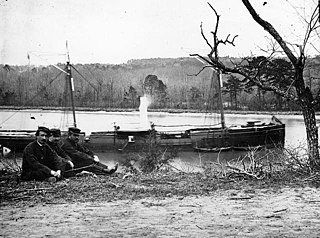
USS Kansas was a gunboat constructed for the Union Navy during the middle of the American Civil War. She was outfitted with heavy guns and assigned to the Union blockade of the waterways of the Confederate States of America. She was the first U.S. Navy ship to be named Kansas and was the first of a class of 836-ton screw steam gunboats. At war's end, she continued serving her country by performing survey work and defending American interests in Cuba until sold in 1883.

The 1889 Apia cyclone was a tropical cyclone in the South Pacific Ocean, which swept across Apia, Samoa on March 15, 1889, during the Samoan crisis. The effect on shipping in the harbour was devastating, largely because of what has been described as "an error of judgement that will forever remain a paradox in human psychology".

USS Wheeling (PG-14) was a Wheeling-class gunboat acquired by the U.S. Navy in 1897. She served as a gunboat during the Spanish–American War as well as a convoy escort during World War I. As IX-28 she also served as a schoolship for the training of Naval Reservists, and, at the end of World War II, just before being struck from the Navy records, she was temporarily assigned as a barracks ship for torpedo boat crews.
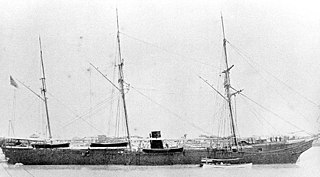
USS Wachusett – the first U.S. Navy ship to be so named – was a large (1,032-ton), Mohican-class steam sloop-of-war that served the United States Navy during the American Civil War. She was outfitted as a gunboat and used by the Navy as part of the Union blockade of the Confederate States of America.
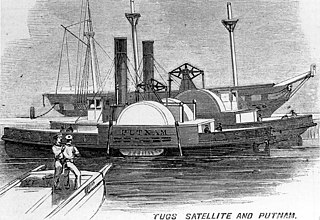
USS General Putnam – also known as the USS William G. Putnam – was acquired by the Union Navy during the first year of the American Civil War and outfitted as a gunboat and assigned to the Union blockade of the Confederate States of America. She also served as a tugboat and as a ship's tender when so required.

USS Underwriter was a 341-ton sidewheel steamer that was purchased for military use by the Union Navy during the American Civil War.

The USS Harvest Moon was a steam operated gunboat acquired by the Union Navy during the American Civil War. She was used by the Navy to patrol navigable waterways of the Confederacy to prevent the South from trading with other countries.
USS Western World was a ship acquired by the Union Navy during the American Civil War. She was used by the Navy to patrol navigable waterways of the Confederacy to prevent the South from trading with other countries.
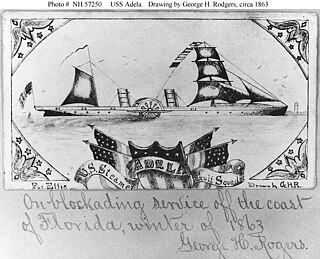
USS Adela was a steamer captured by the Union Navy during the American Civil War. She was used by the Union Navy as a gunboat in support of the Union Navy blockade of Confederate waterways.
USS George Mangham was a schooner acquired by the Union Navy during the American Civil War. She was used by the Union Navy as a gunboat in support of the Union Navy blockade of Confederate waterways.
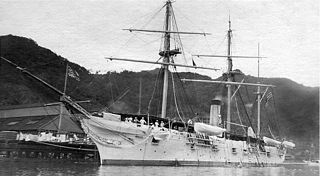
USS Adams was a screw gunboat and the lead ship of the Adams class. She was named for Founding Father and second president of the United States John Adams.

SMS Eber, a 735-ton iron-hulled gunboat, was built at Kiel, Germany for gunboat diplomacy in the Pacific. It was a barque-rigged auxiliary steamer. After commissioning in September 1887 she was sent to the Pacific to serve in the German colonial empire. She disarmed the inhabitants of Nauru in 1888, ending their civil war and annexing the island to the German Empire. Eber was anchored in Apia Harbor, Samoa, during the 1889 Apia cyclone of 15–16 March 1889. Though she was the most modern of the seven warships present, damage to her propeller made it impossible for her to survive the violent wind and seas. After a long struggle, Eber was forced against the edge of the harbor reef and sank quickly, with the loss of 73 of her crewmen.

SMS Adler was a gunboat of the Imperial German Navy. She was launched 3 November 1883 in the Imperial shipyard in Kiel. On 5 September 1888, she shelled Manono Island and Apolima, Samoa, which were strongholds of Malietoa’s forces. She was wrecked together with the German gunboat SMS Eber, the German corvette SMS Olga, the United States Navy gunboat USS Nipsic, the U.S. Navy screw steamer USS Trenton, and the U.S. Navy sloop-of-war USS Vandalia on 16 March 1889 in a hurricane at Apia, Samoa, during the Samoan crisis. Twenty crew members lost their lives.

The Samoan crisis was a standoff between the United States, the German Empire, and the British Empire from 1887 to 1889 over control of the Samoan Islands during the First Samoan Civil War.

Captain Robert F. R. Lewis was an officer in the United States Navy. He participated in the Paraguay Expedition, fought in the Mexican War and American Civil War, and served briefly as commander of the Asiatic Squadron.




















